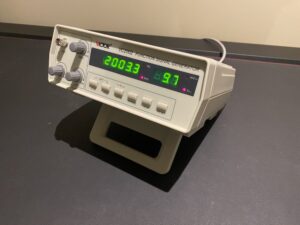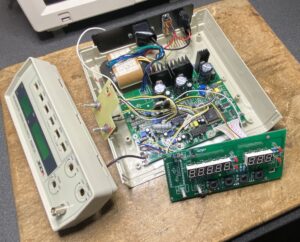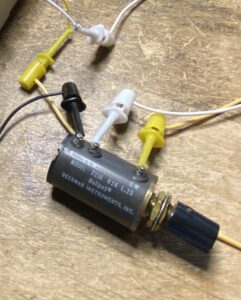I’ve owned a ‘Victor VC2002’ signal generator since 2016. It’s a cheap and cheerful design, based on a (now obsolete) MAX038 signal generator IC, with an AT89C51 micro-controller that handles the display, push buttons and selects one of six reference capacitors that set its frequencies ranges. It was a bargain, bought via eBay for $65 and has been working perfectly until recently.
A few months ago, its output frequency started drifting away from the desired set point after a 15 minutes use. Then, after 5 mins use and eventually, all the time. I had previously replaced it with a very nice Arbitrary Frequency Generator, which cost me ten times a much, and provides me with a great range of capabilities.

Figure 1. VC2002
I decided to track down a schematic for the VC2002 and have a go at repairing it, as it is sometimes very handy if I need an audio-range sine-wave and want to twiddle with the unit’s control knobs to rapidly change frequency, output level or waveform symmetry.

Figure 2. Unit with top removed (built in 2002).
I found a schematic that showed the core circuitry, but did not include the power supply. But as the issue was probably centred around the MAX038, I decided to run with what I had found.
I checked through all the circuitry, tested the power power-supply voltages – all okay. The AVR had no issues. The display worked fine, as did the various push button inputs and the selection of the applicable capacitors for the MAX038.
Next, on to the MAX038.
The frequency set point is controlled via a Chinese made 10 turn 2K2 wire-wound potentiometer, the wiper of which feeds anywhere between 0v to -15v to a circuit that connects to pin 10 of the MAX038. Connecting the wiper-lead to -15v ran the unit at the high end of the selected frequency range, and connecting it to 0v ran the unit at the low end, with no drift at all. Connecting the 2K2 pot back in caused the usual drift.
Next test was to temporarily replace the 2K2 pot with something equivalent. I found a nice old Beckman precision 1K wire-wound pot in my ‘legacy parts’ box and fitted it in place. I think I’ve had it since the mid-1980s. Although the 1K value shifted the low/high setting of the frequency range a bit, the pot work just fine. No apparent drift at all.

Figure 3. Beckman potentiometer
I left the unit running with this pot in place for a few hours. Upon return, the unit was still running at the desired set point. Then I left it running overnight. Still no drift. Yay! Problem resolved. (It also says something about the longevity of the Beckman pot I used).
The Beckman pot was not physically compatible with the unit, so I procured a suitable precision 10-turn 2K2 wire-wound potentiometer and fitted it into the unit. And for the sake of product longevity, I replaced the six reference capacitors with high quality audio capacitors.
The VC2002 is back to normal, and hopefully will last quite a few more years.